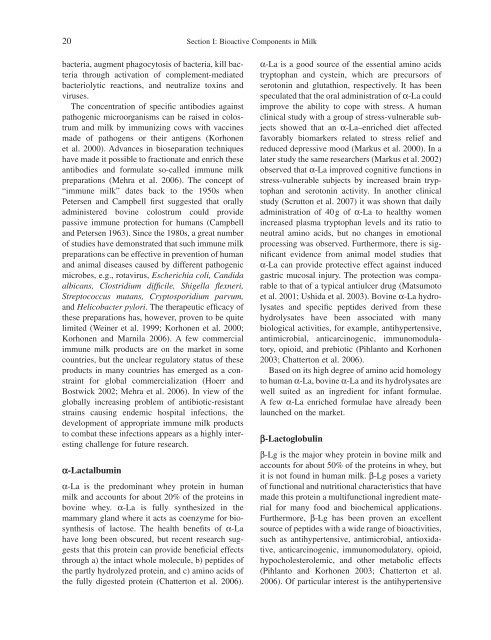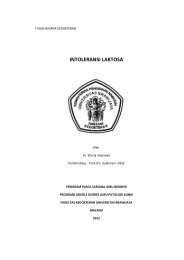Bioactive Components in Milk and Dairy Products - Prof. Dr. Aulanni ...
Bioactive Components in Milk and Dairy Products - Prof. Dr. Aulanni ...
Bioactive Components in Milk and Dairy Products - Prof. Dr. Aulanni ...
You also want an ePaper? Increase the reach of your titles
YUMPU automatically turns print PDFs into web optimized ePapers that Google loves.
20 Section I: <strong>Bioactive</strong> <strong>Components</strong> <strong>in</strong> <strong>Milk</strong><br />
bacteria, augment phagocytosis of bacteria, kill bacteria<br />
through activation of complement - mediated<br />
bacteriolytic reactions, <strong>and</strong> neutralize tox<strong>in</strong>s <strong>and</strong><br />
viruses.<br />
The concentration of specifi c antibodies aga<strong>in</strong>st<br />
pathogenic microorganisms can be raised <strong>in</strong> colostrum<br />
<strong>and</strong> milk by immuniz<strong>in</strong>g cows with vacc<strong>in</strong>es<br />
made of pathogens or their antigens (Korhonen<br />
et al. 2000 ). Advances <strong>in</strong> bioseparation techniques<br />
have made it possible to fractionate <strong>and</strong> enrich these<br />
antibodies <strong>and</strong> formulate so - called immune milk<br />
preparations (Mehra et al. 2006 ). The concept of<br />
“ immune milk ” dates back to the 1950s when<br />
Petersen <strong>and</strong> Campbell fi rst suggested that orally<br />
adm<strong>in</strong>istered bov<strong>in</strong>e colostrum could provide<br />
passive immune protection for humans (Campbell<br />
<strong>and</strong> Petersen 1963 ). S<strong>in</strong>ce the 1980s, a great number<br />
of studies have demonstrated that such immune milk<br />
preparations can be effective <strong>in</strong> prevention of human<br />
<strong>and</strong> animal diseases caused by different pathogenic<br />
microbes, e.g., rotavirus, Escherichia coli, C<strong>and</strong>ida<br />
albicans, Clostridium diffi cile, Shigella fl exneri,<br />
Streptococcus mutans, Cryptosporidium parvum,<br />
<strong>and</strong> Helicobacter pylori . The therapeutic effi cacy of<br />
these preparations has, however, proven to be quite<br />
limited (We<strong>in</strong>er et al. 1999 ; Korhonen et al. 2000 ;<br />
Korhonen <strong>and</strong> Marnila 2006 ). A few commercial<br />
immune milk products are on the market <strong>in</strong> some<br />
countries, but the unclear regulatory status of these<br />
products <strong>in</strong> many countries has emerged as a constra<strong>in</strong>t<br />
for global commercialization (Hoerr <strong>and</strong><br />
Bostwick 2002 ; Mehra et al. 2006 ). In view of the<br />
globally <strong>in</strong>creas<strong>in</strong>g problem of antibiotic - resistant<br />
stra<strong>in</strong>s caus<strong>in</strong>g endemic hospital <strong>in</strong>fections, the<br />
development of appropriate immune milk products<br />
to combat these <strong>in</strong>fections appears as a highly <strong>in</strong>terest<strong>in</strong>g<br />
challenge for future research.<br />
α - Lactalbum<strong>in</strong><br />
α - La is the predom<strong>in</strong>ant whey prote<strong>in</strong> <strong>in</strong> human<br />
milk <strong>and</strong> accounts for about 20% of the prote<strong>in</strong>s <strong>in</strong><br />
bov<strong>in</strong>e whey. α - La is fully synthesized <strong>in</strong> the<br />
mammary gl<strong>and</strong> where it acts as coenzyme for biosynthesis<br />
of lactose. The health benefi ts of α - La<br />
have long been obscured, but recent research suggests<br />
that this prote<strong>in</strong> can provide benefi cial effects<br />
through a) the <strong>in</strong>tact whole molecule, b) peptides of<br />
the partly hydrolyzed prote<strong>in</strong>, <strong>and</strong> c) am<strong>in</strong>o acids of<br />
the fully digested prote<strong>in</strong> (Chatterton et al. 2006 ).<br />
α - La is a good source of the essential am<strong>in</strong>o acids<br />
tryptophan <strong>and</strong> cyste<strong>in</strong>, which are precursors of<br />
seroton<strong>in</strong> <strong>and</strong> glutathion, respectively. It has been<br />
speculated that the oral adm<strong>in</strong>istration of α - La could<br />
improve the ability to cope with stress. A human<br />
cl<strong>in</strong>ical study with a group of stress - vulnerable subjects<br />
showed that an α - La – enriched diet affected<br />
favorably biomarkers related to stress relief <strong>and</strong><br />
reduced depressive mood (Markus et al. 2000 ). In a<br />
later study the same researchers (Markus et al. 2002 )<br />
observed that α - La improved cognitive functions <strong>in</strong><br />
stress - vulnerable subjects by <strong>in</strong>creased bra<strong>in</strong> tryptophan<br />
<strong>and</strong> seroton<strong>in</strong> activity. In another cl<strong>in</strong>ical<br />
study (Scrutton et al. 2007 ) it was shown that daily<br />
adm<strong>in</strong>istration of 40 g of α - La to healthy women<br />
<strong>in</strong>creased plasma tryptophan levels <strong>and</strong> its ratio to<br />
neutral am<strong>in</strong>o acids, but no changes <strong>in</strong> emotional<br />
process<strong>in</strong>g was observed. Furthermore, there is signifi<br />
cant evidence from animal model studies that<br />
α - La can provide protective effect aga<strong>in</strong>st <strong>in</strong>duced<br />
gastric mucosal <strong>in</strong>jury. The protection was comparable<br />
to that of a typical antiulcer drug (Matsumoto<br />
et al. 2001 ; Ushida et al. 2003 ). Bov<strong>in</strong>e α - La hydrolysates<br />
<strong>and</strong> specifi c peptides derived from these<br />
hydrolysates have been associated with many<br />
biological activities, for example, antihypertensive,<br />
antimicrobial, anticarc<strong>in</strong>ogenic, immunomodulatory,<br />
opioid, <strong>and</strong> prebiotic (Pihlanto <strong>and</strong> Korhonen<br />
2003 ; Chatterton et al. 2006 ).<br />
Based on its high degree of am<strong>in</strong>o acid homology<br />
to human α - La, bov<strong>in</strong>e α - La <strong>and</strong> its hydrolysates are<br />
well suited as an <strong>in</strong>gredient for <strong>in</strong>fant formulae.<br />
A few α - La enriched formulae have already been<br />
launched on the market.<br />
β - Lactoglobul<strong>in</strong><br />
β - Lg is the major whey prote<strong>in</strong> <strong>in</strong> bov<strong>in</strong>e milk <strong>and</strong><br />
accounts for about 50% of the prote<strong>in</strong>s <strong>in</strong> whey, but<br />
it is not found <strong>in</strong> human milk. β - Lg poses a variety<br />
of functional <strong>and</strong> nutritional characteristics that have<br />
made this prote<strong>in</strong> a multifunctional <strong>in</strong>gredient material<br />
for many food <strong>and</strong> biochemical applications.<br />
Furthermore, β - Lg has been proven an excellent<br />
source of peptides with a wide range of bioactivities,<br />
such as antihypertensive, antimicrobial, antioxidative,<br />
anticarc<strong>in</strong>ogenic, immunomodulatory, opioid,<br />
hypocholesterolemic, <strong>and</strong> other metabolic effects<br />
(Pihlanto <strong>and</strong> Korhonen 2003 ; Chatterton et al.<br />
2006 ). Of particular <strong>in</strong>terest is the antihypertensive





